Are Lobsters And Crabs Related? (How Closely?)
You may have noticed that lobsters and crabs have some similarities in their appearance or their behavior and habitat. They have claws, many walking legs and live on the bottom of the ocean. Therefore, if you wonder if lobsters and crabs are related, in this article, we’ll talk all about that. However, let’s begin with a quick answer:
Lobsters and crabs are closely related as they belong to the same phylum Arthropoda, subphylum Crustacea, and Malacostraca class. They have a lot of similarities, such as their exoskeleton, jointed legs, or compound eyes.
However, this certainly doesn’t tell the whole story. Below I’ll explain more about why lobsters and crabs are related and what are the main differences and similarities between them. Furthermore, I’ll explain more about what other animals lobsters are related to. Read on!
Similarities between lobsters and crabs
Lobsters and crabs have also a lot of similarities as they belong to the same phylum and class. Below you can read about the biggest similarities between them.
Classification
The first similarity between lobsters and crabs is their classification which explains how these animals are related. Animal kingdom classification is a system that helps us to understand how all living organisms are related. This system divides the animal kingdom into phylum, subphylum, class, order, suborder, family, genus, and species.
Lobsters and crabs belong to the phylum Arthropoda as they share a common ancestor. They also, together with crayfish, shrimp, krill, prawns, or woodlice, belong to the class Malacostraca. This class is part of the subphylum Crustacea, and all animals in this class are called crustaceans.

Jointed legs
The name of the phylum Arthropods that both lobsters and scrabs belong to means “jointed legs” (arthro = joint, pod = foot). All these animals have a hard exoskeleton that could create a problem with the flexibility of their appendages. This is where having jointed legs solves the problem.
Most of the appendages of lobsters and crabs bend at joints, which are softer and bendable. This allows them to create a movement similar to what a suit of armor does. These animals control limbs by contracting their muscles connected to the exoskeleton on both sides of the joint.
Body segmentation
One of the similarities between lobsters and crabs is their body segmentation. Their bodies are divided into two different parts: a cephalothorax and an abdomen. The cephalothorax is a fusion of the head and the thorax (the middle body part). The cephalothorax contains the antennae, eyes, mouthparts, and legs.
The abdomen is a flexible tail that, in lobsters’ case, allows them to swim rapidly to escape predators. When it comes to crabs, their abdomen is not that easily visible. The reason is that their tail is normally wrapped under their body and pressed against the thorax. They use it for reproduction as their sex organs are located there.
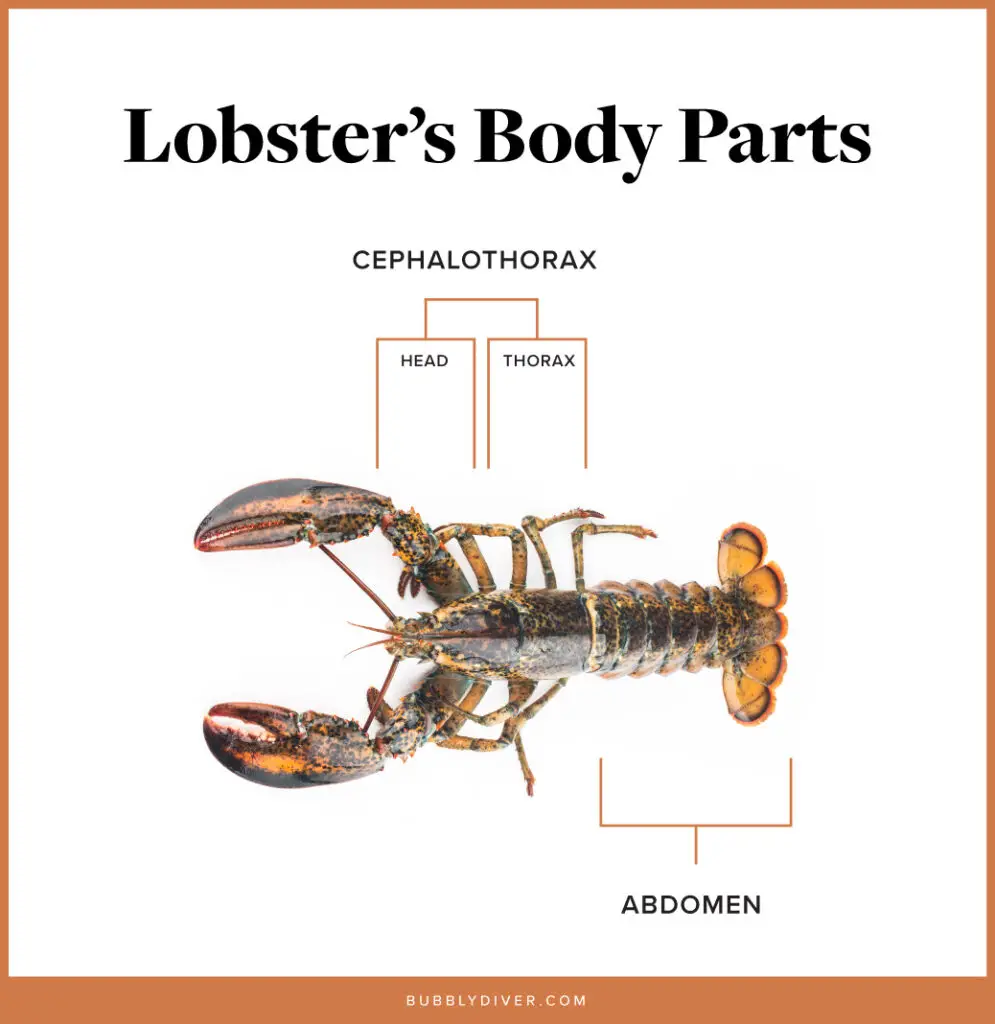
Exoskeleton
Both scorpions and crabs have an exoskeleton, which is an external skeleton. These animals are fully covered by this hard and calcified shell, which supports and protects their bodies. They don’t have any internal skeletons, which makes their internal systems very delicate.
Interestingly, exoskeletons don’t expand as animals grow inside them. Therefore, lobsters and crabs have to molt their “shells” as they grow larger. In order to do it, they usually crack the outer shell in one spot and flex their body repeatedly until they’re finally out of the old shell.
The frequency of molting depends on the animal’s life cycle – younger individuals grow faster than older ones. Juvenile lobsters can molt every few days/weeks, and adult species molt once every year or once every two years.
Antennae
Another similarity between these two animals is the pair of antennae. Interestingly, only crustaceans in phylum Arthropoda have antennae. It’s a very sensitive organ, and they use it to smell and locate food as well as to sense danger. Antennae are located in front of their heads, and depending on the animals and species, their length can differ. Crabs have very short antennae compared to lobsters.
Spiny, non-clawed lobsters have very long antennae that help them protect themselves from predators. Lobsters with claws, however, have shorter and thinner antennae, but they use their claws as a primary defense mechanism.
Bilateral symmetry
All arthropods, including crabs and lobsters, have a bilateral symmetry, which means the right half of their bodies is the mirror image of their left half — just like human bodies. The internal organs, however, aren’t necessarily placed symmetrically.
Eyes
All crustaceans have eyes called compound eyes, meaning they consist of hundreds or thousands of tiny light-sensitive parts (called ommatidia). Each of these units serves to focus light on the retina and create a portion of an image. Both lobsters and crabs have them located on stalks.
These animals can detect fast movements, and their vision is in black and white only. They have limited image resolution but possess high sensitivity and can detect fast movement and the polarization of light as well.
Appendages
All crustaceans have many appendages, but the number and function strongly depend on the specific species. Most of them have seven or more pairs, and their primary functions are feeding, walking, swimming, reproduction, or respiration.
In general, lobsters have five pairs of appendages. Their legs (called pereiopods), however, can be slightly modified, depending on the lobster’s species. For instance, clawed lobsters have the first pair of legs modified into large claws and two following legs modified into small claws.
Crabs, just like lobsters, have five pairs of legs. Also, the same as clawed lobster species, their first pair of legs is modified into claws. They use them to catch prey, tear the food apart, or fight other crabs. Both lobsters and crabs have two slightly different-looking claws: a crusher and a pincer claw.
The larger claw is called the crusher claw and is used to crush food as it’s more massive. This claw is located on the right side of the animal if the individual is right-handed, but there are left-handed crabs and lobsters as well. The smaller claw is called the pincer claw and is used to rip into the prey.
Gills
Another common feature of crabs and lobsters is the way they breathe. They all primarily use gills for respiration, and by using them, they absorb the oxygen from the water. Lobsters breathe by first taking the water in through the opening between their legs and then by absorbing the oxygen.
Interestingly, they can survive out of water for a certain amount of time if their lungs stay moist. They must stay moist, though, because they can’t absorb it directly from the air. Crabs also use gills the same way as lobsters do, so even though you see crabs on land, they keep their gills moist in order to breathe.
However, they are some land crab species that live primarily on land and could even drown in the water. For instance, coconut crabs use branchiostegal lungs in order to breathe. These animals absorb oxygen directly from the air, and we can say that their respiratory organ is in a developmental stage between the gills and lungs.
Reproduction
Lobsters and crabs reproduce sexually, which involves the fusion of a sperm with an egg. During mating, the male deposits a sperm package, and a female carries male sperm until the eggs are ready to be fertilized. She carries the eggs under the abdomen for months until they hatch.
Next, they go through a series of metamorphoses. We can divide the life cycle of lobsters and crabs into four stages: eggs, larvae, juvenile, and adult stages. Read more about lobsters’ reproduction and life cycle in my other blog post: “The Complete Life Cycle Of Lobsters (+ Reproduction)”.
Habitat
Another similarity between lobsters and crabs is their habitat. They live on sandy or rocky seafloor, where they hide under rocks or inside the reef. Depending on the species, they can be found in colder or tropical waters. For instance, clawed lobsters can be found in the North Atlantic Ocean, and spiny lobsters in the Caribbean waters.
Crabs can also live on rocky shores in very shallow areas or on the beach.
The differences between lobsters and crabs
Classification
Lobsters and crabs and classified into the same phylum and class, but they’re not the same animals. Despite phylum, subphylum, and class, we can also distinguish order, family, genus, and species. Lobsters belong to the Nephropidae family, and crabs to Carcinidae.
Lifespan
Lifespan is one of the biggest differences between lobsters and crabs. The average lifespan of crabs is about three to five years, but there were some crabs living up to 30 years. This strongly depends on species, conditions, food availability, etc.
Lobsters, from what we know so far, can live even over 100 years! They also don’t age the way most animals do because they keep growing and reproducing all their life. However, they’re immortal, and they usually die from exhaustion during the molting process.
Habitat
Even though I pointed out the habitat as a similarity between lobsters and crabs, there are also a lot of differences when we look at the specific species. Some crabs primarily live on land and beach, and lobsters never do that.
Another difference is that crabs can live in freshwater environments, such as Fiddler Crab and Thai Devil Crab. Lobsters live only in oceans and seas and cannot survive in freshwater.
Locomotion
As you may already know, most crabs walk sideways. They do that because their stiff, jointed legs make it faster and easier. They can also walk forward and backward, but it’s just inefficient. Lobsters primarily move forward and backward, but when they want to escape quickly, they swim backward by flexing their abdomen.
The shape of the body
Crabs’ bodies are more circular, and lobsters have longer bodies. The reason for that is the difference in their abdomen. Crabs’ abdomen is wrapped under their body and pressed against the thorax, and lobsters’ is not.
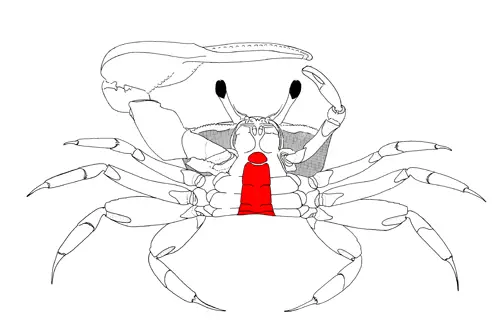
What other animals are closely related to lobsters?
We established that crabs and lobsters belong to the same subphylum Crustacea. What other animals are crustaceans and are related to lobsters?
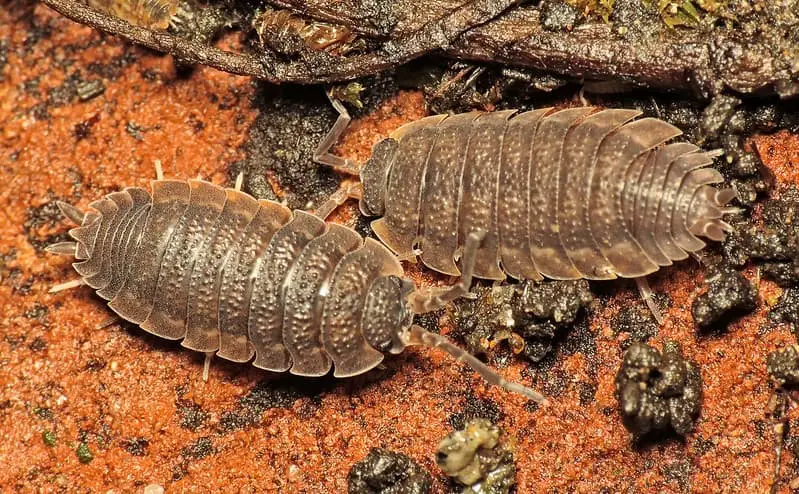
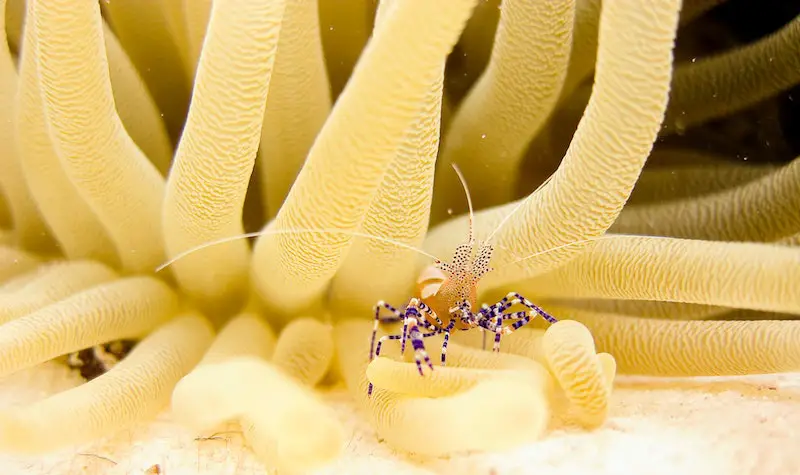
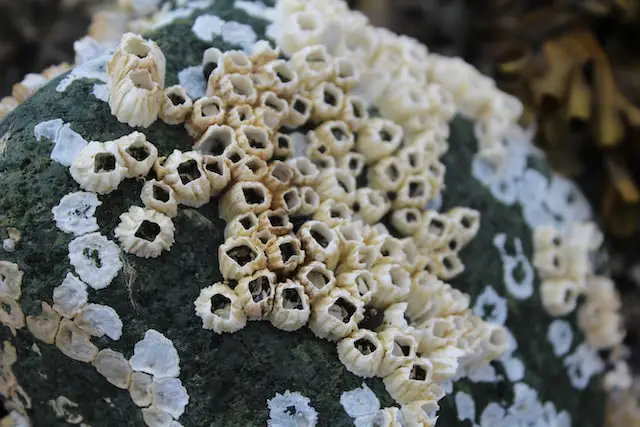
The crustacean group consists of about 45000 invertebrate species living in every corner of our oceans and seas. The most known species (except lobsters and crabs) are shrimps, woodlice, barnacles, krill, crayfish, prawns, fish lice, and copepods.
Most of them are exclusively aquatic animals, but some live on land. An example of crustaceans living on land is woodlice or sandhoppers. Surprisingly, they breathe through their gills which are attached to the swimming legs on their abdomen. Therefore, they need to stay moist all the time in order to breathe, and they can survive for about an hour out of water.
You may also like:

Welcome to Bubbly Diver!
I’m glad to see you here. This blog is created for all marine creature lovers by a bubbly diver - me, Dori :)


